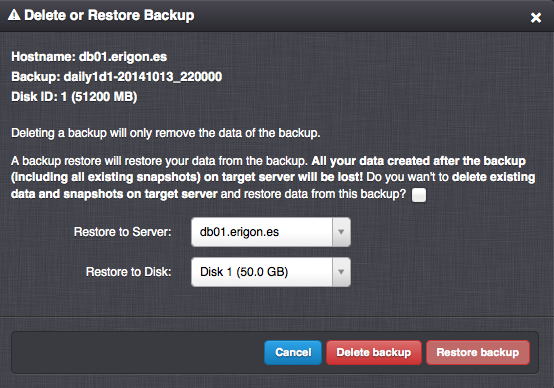Virtual Server Backups¶
A Backup is a snapshot of a virtual server disk moved to an off-site location.

| Access Permissions | |
| SuperAdmin | read-write |
| DCAdmin | read-write |
| VmOwner | read-only |
Backups Parameters¶
Name - Backup name (read-only).
Disk ID - Virtual server disk ID (read-only).
Type - Backup type (read-only). One of:
- Dataset
- File
Created - The date and time when the backup was created (read-only).
Status - Backup state (read-only). One of:
- ok
- pending
- restore
- lost
Duration - The amount of time spent to create the backup (read-only).
Size - The size of the backup (read-only).
Note
Note
Backups created with the Freeze filesystem option enabled are marked with a flag icon appended to their status.
Backup Actions¶
Backup now - Immediately start a backup process based on a backup definition.

Delete backup - Remove data of the backup.

Restore backup - Restore server disk data from the backup to the existing virtual server disk or a disk of an another virtual server.
Warning
A backup restore results in all data loss on the target virtual server and disk, including all virtual server’s snapshots.
Warning
Backing up many virtual servers at the same time can have a high impact on the I/O load of the affected compute and backup nodes, potentially causing short or even long-term unavailability of services. A fair distribution of backup schedules in time can easily eliminate this problem. A backup definition overview of a particular virtual data center or backup node can be obtained via the compute node backup definition view or API:
user@laptop:~ $ es get /vm/define/backup -dc admin -full --tabulate
user@laptop:~ $ es get /node/node99.example.com/define/backup -full --tabulate
Backup Definitions¶
A Backup Definition is a configuration based on which periodic backups are automatically created and deleted.

| Access Permissions | |
| SuperAdmin | read-write |
| DCAdmin | read-write |
| VmOwner | read-only |
Backup Definition Parameters¶


Name - Backup definition name.
Disk ID - Virtual server disk ID.
Backup type - One of:
- Dataset - Backups are created by using ZFS datasets in an incremental way (optimal and recommended).
- File - Backups are created by storing full ZFS datasets into files (can be used to store backups onto remote data storages connected via NFS or Samba).
Backup node - Compute node with backup capabilities enabled.
Storage - Name of the node storage on the chosen backup node.
Schedule - Automatic scheduler configuration in Cron format. Use your local time for the hour field (it will be internally converted into UTC).
Retention - Maximum number of backups to keep. After exceeding this number of backups the oldest backup associated with the backup definition will be automatically removed.
Active - Whether the backup definition is active.
Description
Compression - Compression of File backups. One of: off (no compression), gzip (fast compression), bzip2 (more effective compression).
Bandwidth limit - Backup speed limit in bytes per second.
Advanced Backup Definition Parameters¶
- Freeze filesystem? - Whether to create application-consistent backups (KVM only). Requires QEMU Guest Agent to be running inside the virtual server.
Cron Format¶
Cron format is a flexible way to define time and frequency of running a periodic task. It is defined as a string of five fields separated by a space.
| Field name | Allowed values |
|---|---|
| Minutes | 0-59 |
| Hours | 0-23 |
| Day of month | 1-31 |
| Month | 1-12 (January - December) |
| Day of week | 0-6 (Sunday - Saturday) |
Examples
30 08 10 06 *- Run a task once every year on June 10 at 8:30 AM.00 11,16 * * *- Run a task twice a day at 11:00 AM and 4:00 PM.00 09-17 * * *- Run a task once every hour between 9:00 AM and 5:00 PM.00 09-18 * * 1-5- Run a task once every hour between 9:00 AM and 5:00 PM from Monday till Friday.* * * * *- Run a task once every minute.0,10,20,30,40,50 * * * *- Run a task once every 10 minutes.0,2,4,6,8,10 * * * *- Run a task every 2 minutes during the first 10 minutes of a hour.0 0 1 1 *- Run a task once a year at midnight of January 1.0 0 * * *- Run a task once a day at midnight.0 * * * *- Run a task once an hour at the beginning of the hour.